| Delta Single Shot Autocorrelator | MiniScan-25PS to 200PS | MiniScan-15PS up to 30PS | |
|---|---|---|---|
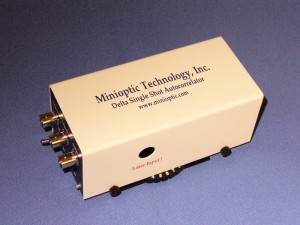 | 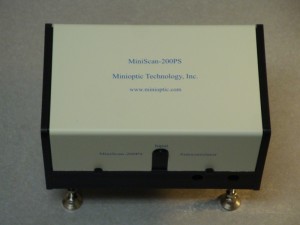 | 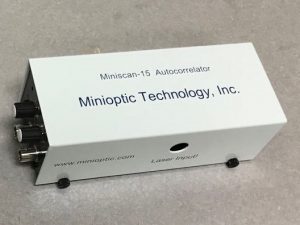 |
MINIOPTIC Autocorrelator Family
MINIOPTIC Autocorrelators
- The autocorrelator product family by MINIOPTIC includes a variety of impressive features and properties, designed for a wide range of ultrafast laser applications. MINIOPTIC provides both standard and customized solutions for even the most sophisticated requirements.
- The technology behind MINIOPTIC products makes it possible to measure ultrashort pulses from femtoseconds to picoseconds, with either Second Harmonic Generation (SHG) detection or Two Photon detection principle, to suit your individual measurement needs.
MINIOPTIC Autocorrelators at a Glance
- Single short autocorrelator for single shot to GHz
- MiniScan series Scanning autocorrelators for<10 Hz to GHz
- Wide choice of optics and detector sets for large pulse width and wavelength range
- Ready to use software and USB interface
- Wide wavelength range from 400 nm to 12 μm
- Wide range of pulse widths from < 10 fs to 200 ps
- Compact footprint with the Delta and MiniScan line
Autocorrelator Models
- MiniScan-15PS
- MiniScan-25PS
- MiniScan-50PS
- MiniScan-100PS
- MiniScan-200PS
- Delta single shot autocorrelator
Optics and Detector Technology
The MINIOPTIC range of different detector types and Optics Sets options enable you to cover a wide diversity of professional applications. The detectors are highly sensitive up to 10-6 W2 and are therefore ideal for pulse measurement at very low pulse energies. In combination with highly efficient optics, these detectors pave the way for measurements across an extensive wavelength spectrum from 400 nm to 12 μm
MiniScan Scanning Autocorrelators
MiniScan autocorrelators provides collinear intensity measurement for easy aligment and possible collinear interferometric or fringe-resolved measurements. MiniScan products have very high sensitivity (10-6 W2) for low laser power application as low as <1mW. The high dynamic range of 8 order (108) is suitable to large laser power range. Also MiniScan products are suitable for laser repetition rate from <10Hz to 1GHz.
Delta Single Shot Autocorrelator
Delta single shot autocorrelator is able to measure pulse width of a single laser shot. Delta is a non-collinear configuration and provides a background-free autocorrelation, perfect for lasers of low repetition rate as well as high repetition rate 1Hz-1GHz.
Cost Efficient Options Suitable for Many Applications
Minioptic provides varies cost efficient options for many application need to cover different pulse width range <10fs to 200ps and different wavelength range 400nm-12um. All the options are add-in component and can be replaced easily. The options can reduce the cost greatly and can be order lately. Automatic Phase Matching
Phase-sensitive, nonlinear processes, such as those used by the autocorrelator, require phase matching for highly efficient Second Harmonic Generation. The MiniScan with two-photo sensors achieves this fully automatically for any wavelength range, resulting in precise and fast operation with no manual adjustment needed. Because they perform the task of both detector and nonlinear optics, the two-photo detectors provide tuning-free operation over a wide wavelength range.USB Interface and Acquisition Software
Delta and MiniScan models are standalone unit, which can be monitored by an oscilloscope. For computer operation a USB interface is provided. The USB interface comes with a complete and easy to use data acquisition software, allowing for real-time data display. With the USB interface user can simply install the program and then run without the pain to write to a program.
MiniScan Compact and Tuning-free Autocorrelator
The MiniScan Models with two-photo sensor is the perfect combination of tuning-free autocorrelation measurement, compact size and high sensitivity.
- Standalone unit for oscilloscope monito
- USB interface option with software for computer operation
• Exchangeable Optics Sets for spectral coverage from 400 nm to 3400 nm
• Tuning-free two-photo detection process
• Compact design for minimum space requirements and maximum portability
• Ultra-precise delay resolution
• Hybrid collinear intensity autocorrelation
• Gaussian, and Lorentzian fitting routines
Tuning-Free Wavelength Matching
Conventionally, autocorrelators used to split an optical pulse into two replicas and recombine them for the Second Harmonic Generation (SHG) in a nonlinear crystal. The MINIOPTIC MiniScan models instead benefit from the two photon detection principle. This eliminates the need of SHG crystal angle tuning and makes the wavelength tuning process unnecessary.
Blue Range without Cross-Correlation
Together with an Blue Optics Set, the MiniScan provides simple pulse width measurement in the Blue range from 400 nm — without the need for cross-correlation. Elimination of the cross-correlation approach also makes the data evaluation easier, by cutting the conventional two-step process to a single-step solution.
Ultra-wide Wavelength Coverage in Compact Design
MINIOPTIC provides a selection of exchangeable Optics Sets, ranging from 400 nm to IR at 3400 nm, for sensitive measurements across an extremely broad wavelength region. Due to its compact footprint, the MiniScan is also the perfect answer to your space-saving and easy portability requirements.
Autocorrelator Principles
Optical Autocorrelators are devices for measuring the intensity or field autocorrelation function of light, mostly used for determining the pulse width of picosecond or femtosecond pulses, to which an electronic apparatus such as oscilloscope would be too slow. The basic principle of operation of an autocorrelator for a pulse width measurement is to check the correlation of the temporal pulse trace with itself. As in the figure 1, an autocorrelator will contain 4 basic components: (1) an component such as a beam splitter to separate an input pulse into two cope of the pulse, (2) an time delay component to generate a variable time delay between the two pulses, (3) a nonlinear medium component such as second harmonic generation (SHG) crystal to generate an autocorrelation signal as a function of the time delay as the two pulses are superimposed in it, (4) a detector device to record the correlation signal, such as a photodiode or a photomultiplier.
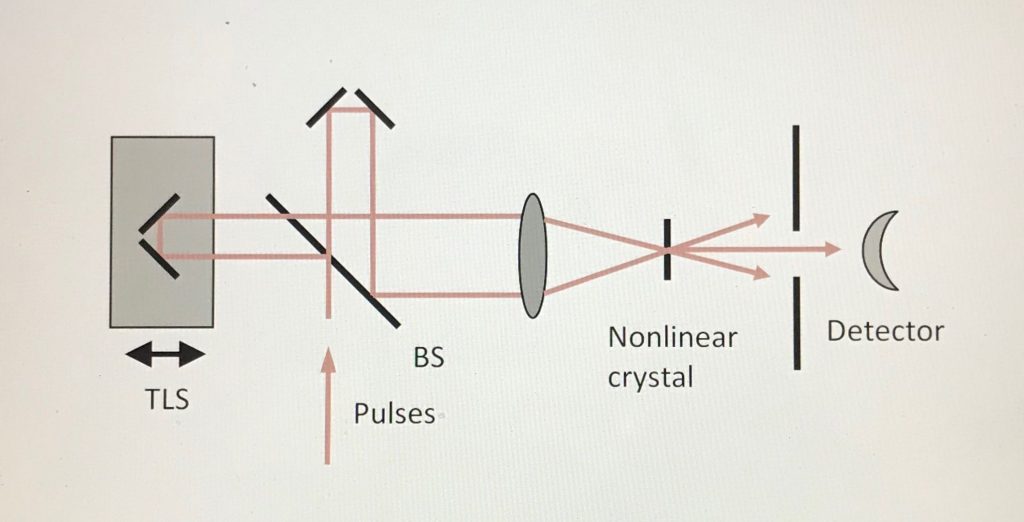
In an intensity autocorrelator as shown in figure 1, a process of sum frequency generation occurs when the two pulses passing the nonlinear (SHG) crystal. The sum frequency signal intensity depends on the time delay variable by moving a translation stage (TLS). The dependence of the autocorrelation signal of the sum frequency on the time delay is given by
This intensity autocorrelator with cross beams can have a background free performance. A trace of autocorrelation signal without background is shown as in figure 2.
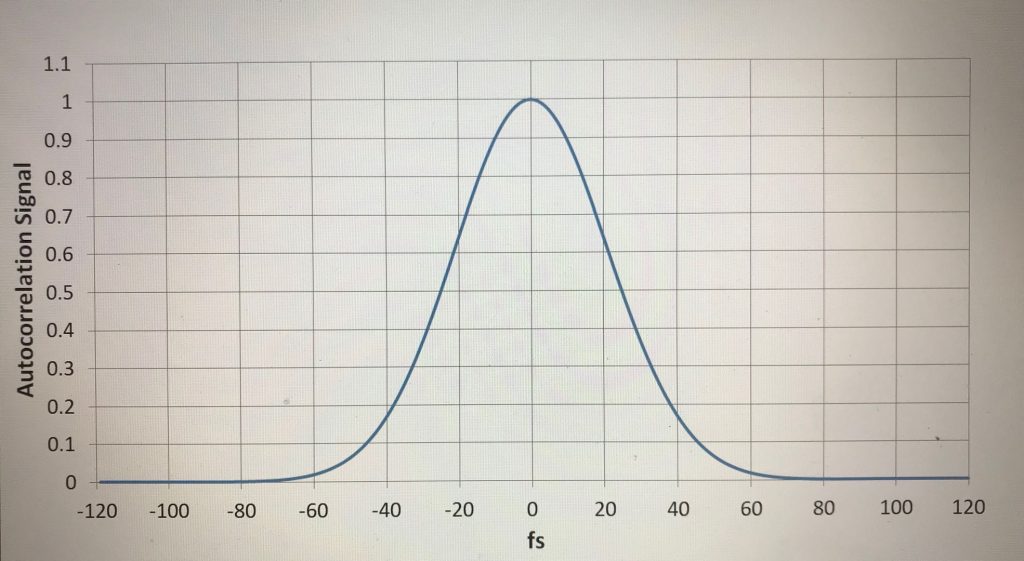
Autocorrelators having a two-photon diode
For an autocorrelator with a SHG crystal the angle of the SHG crystal must be tuned to reach the phase match condition to generate the correlation signal at different wavelength. In the case of frequently wavelength change it is inconvenient to tune the SHG crystal. And the cost of a SHG crystal is high. To overcome the above drawbacks an autocorrelator without a SHG crystal has been constructed. As shown in the figure 3 an autocorrelator without a nonlinear crystal but having a two-photo diode to directly detect the two-photon or SHG signal, combining the component 3 and 4 together. The two-photo diode has response at two-photon or doubling frequency while has no response at the input frequency.
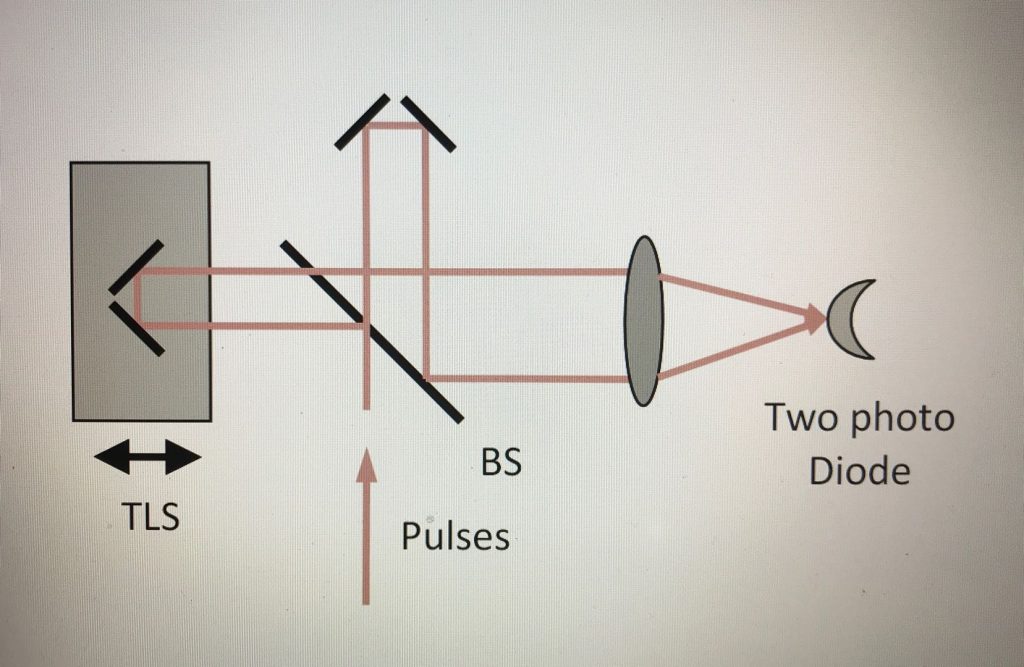
Single shot autocorrelators
The above scanning autocorrelators, having a single channel detector, works well for pulse width measurement of high repetition rate laser but may be difficult to measure pulse width of a low repetition rate laser. It is impossible to measure the pulse width of a single shot pulse using a scanning autocorrelator. To be able to measure a single shot pulse an autocorrelator has to use multi-channel detectors such as CCD to simultaneously record the correlation signal of all time delay. As shown in figure 4 is our Delta single shot autocorrelator which uses a multi-channel detector CCD for single shot and multi shot measurements.
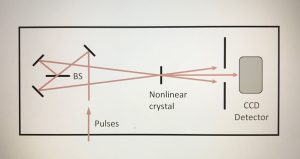
In the Delta single shot autocorrelator two crossed pulses have a time delay distributed along the SHG crystal as shown in figure 5
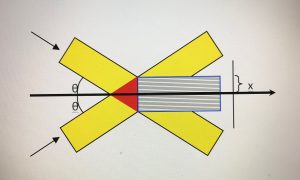
The time delay between the two beams along the cross section is calculated as a function of the cross angle (2θ) of the two beams and the distance (x) from the center,
Δt=(20/3)·x·n·sin(θ),
where n is the diffraction indices of the material, in air n is 1. The time delay Δt is in the unit of picosecond when the distance x is millimeter. Therefore, the generated SHG signal due to the two crossed beams will have an intensity distribution along the x direction depending on the laser pulse width. A longer pulse will generate a broader SHG signal while a shorter pulse will generate a narrower SHG signal along the x direction. For our Delta autocorrelator a 100 fs and a 1 ps pulse will have about 0.1 mm and 1 mm width, respectively. Thus, measuring the intensity of the SHG signal along the x direction will give the pulse width of a laser beam. The SHG signal has to be recorded by a multichannel detector such as CCD. Apparently, the advantage of single shot autocorrelator over scanning autocorrelator is that it can be used for any repetition of laser from single shot to GHz.
Autocorrelator with a rotation time delay line
A rotation time delay line as well as a translational stage is often used in an autocorrelator. As shown in figure 6, a parallel mirror pair is consisted of the rotation time delay line. The pulses reflected by the beam splitter (BS) will pass the mirror pair and is retro reflected back by a mirror to pass the beam splitter. The path length of the pulses will depend on the incident angle θ, which will change as the mirror pair rotates.
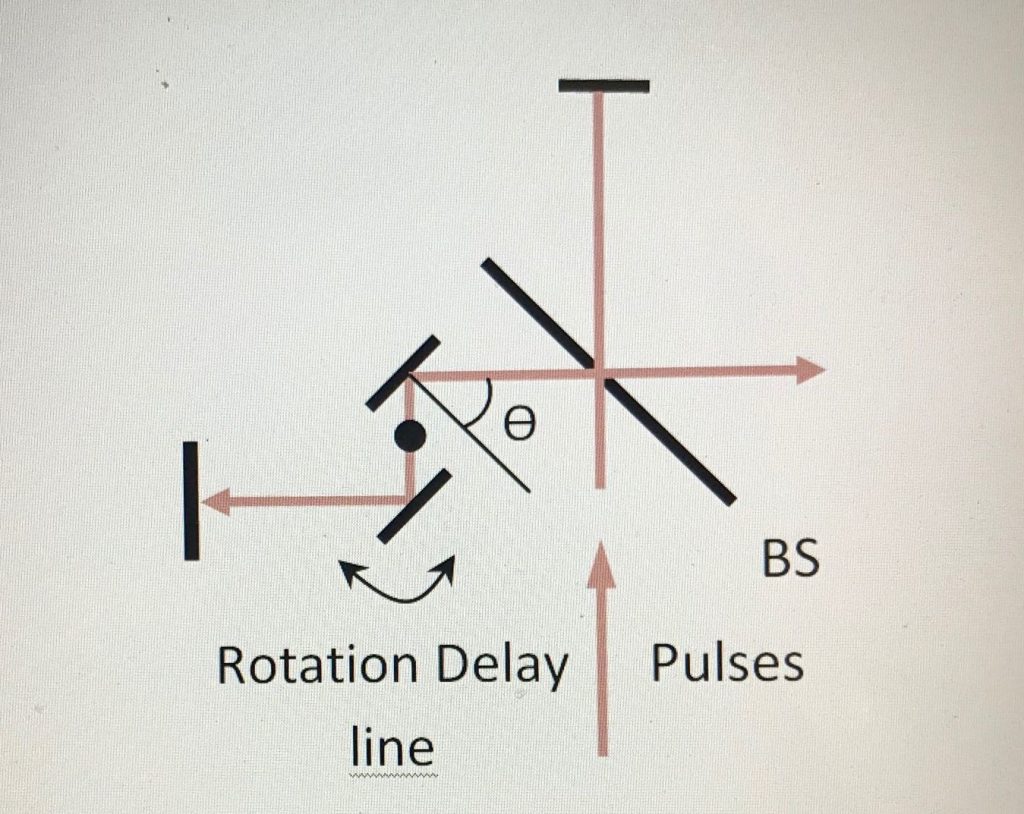
The relative time delay generated by the rotation delay line is
Δt=40·D·cos(θ)/3,
where D is the distance between the two parallel mirrors and the θ is the incident angle of laser beam to the first mirror. The Δt is in the unit of picosecond when D is millimeter.
As an example, Figure 7 shows our MiniScan-15PS autocorrelator with a rotation time delay line.
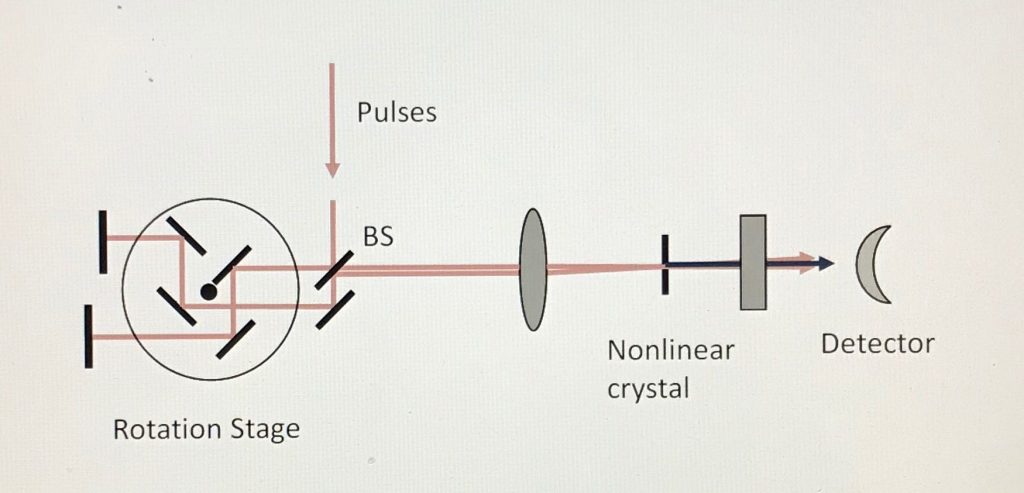
In the MiniScan-15PS, the rotation delay line consists of two pairs of parallel mirrors, which has very good linear relation of the delay time to the rotation angle. The two pulses after the beam splitter are near collinear crossed at the SHG crystal, that is at a very small cross angle. The near collinear configuration makes the alignment much easier, but the autocorrelation signal will contain a background caused by single beam along as shown in the figure 8. The intensity of the correlation signal compared with the background is 1:1, provided that the autocorrelator is properly aligned.
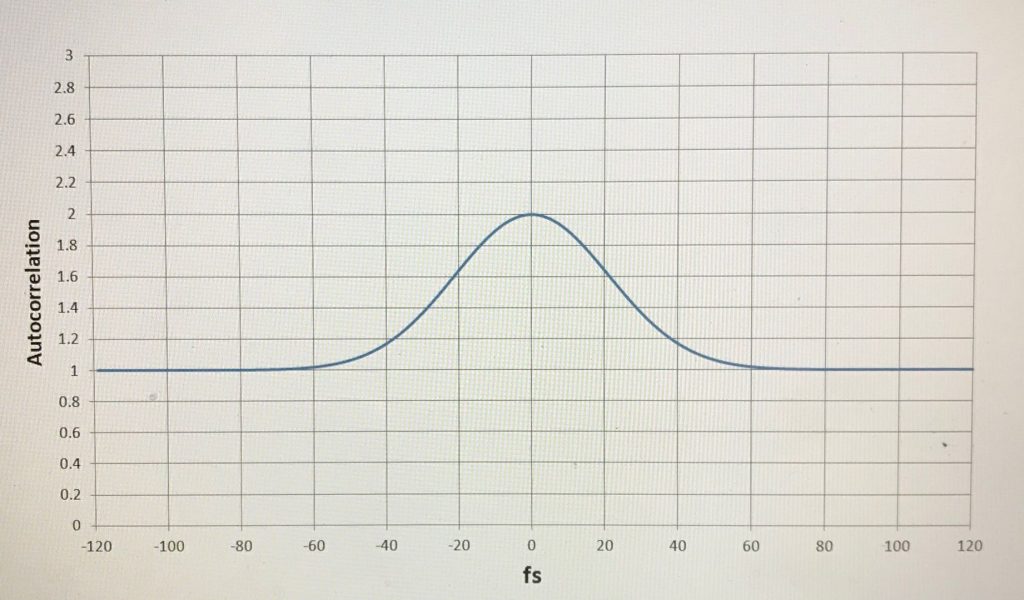
Interferometric Autocorrelators
If the two pulses after the beam splitter is colinearly configured the autocorrelator shown in Figure 8 becomes an interferometric autocorrelator, which contains a Michelson interferometer with a variable arm length difference. The superimposed copies of the pulse are collinearly propagating into the nonlinear crystal. This kind of autocorrelation trace exhibits a fast oscillation with a period of the optical wavelength. The maximum signal (Figure 9) is obtained when the two pulses after the beam splitter undergo perfect constructive interference at zero-time delay. A background signal is generated at the large time delay, at which two pulses lost time overlap. The peak signal is eight times of the background signal, provided that the interferometer is properly aligned.
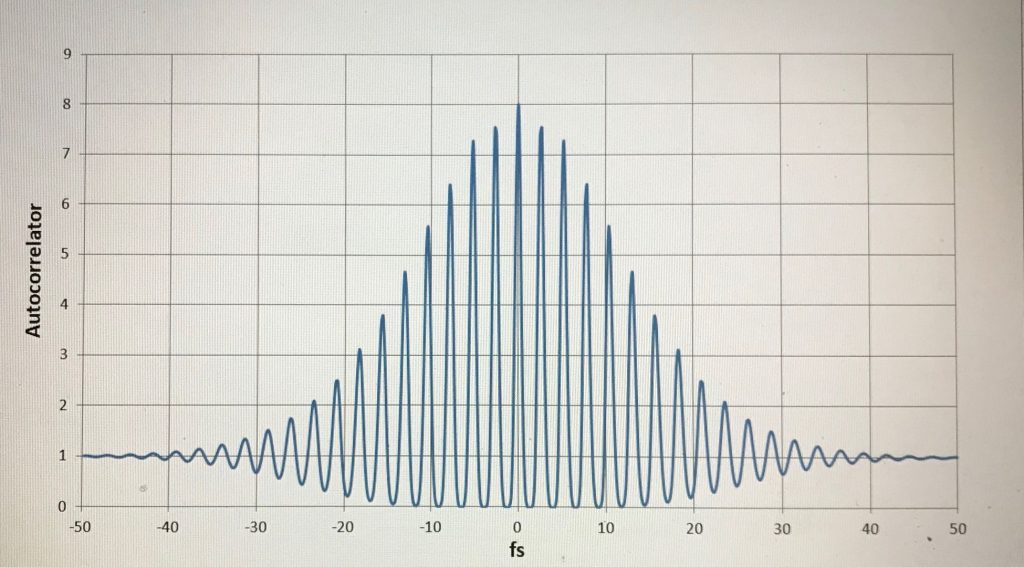
Oscilloscope or computer for autocorrelators
For autocorrelators data display and handling are also important. An oscilloscope can directly display an correlation signal trace while a computer can do much more such as data fitting, display trace, data average and so on. Our Delta single shot and MiniScan autocorrelators can provide both oscilloscope and computer display as customer’s needs.
